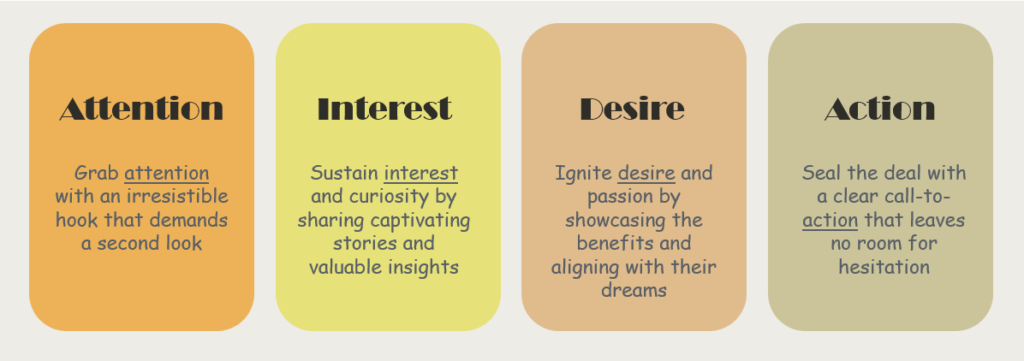Table of Contents
In today’s world, where information overload and advertising saturation have become the norm, it is crucial to find effective ways to capture attention and stand out from the crowd. The AIDA model provides a practical framework that can revolutionize everyday interactions, enabling individuals to captivate and convert people effortlessly.
In this comprehensive guide, we will delve into each stage of the AIDA model, explore its applications beyond marketing, analyze real-life examples, and provide practical strategies for mastering the art of persuasion.
By the end of this article, you will have a deep understanding of the AIDA model and be equipped with the knowledge to influence and inspire others in various aspects of life.
Real-life Examples of the AIDA Model
Martin Luther King Jr.’s “I Have a Dream” Speech
One of the most iconic speeches in history, Martin Luther King Jr.’s “I Have a Dream” speech, perfectly demonstrates the power of the AIDA model. King captured attention by starting with a powerful and emotive statement: “I have a dream.” This immediately grabbed the audience’s attention and created a sense of anticipation. He sustained interest by weaving a compelling narrative of equality and justice, connecting with the audience’s emotions and values.
By sharing personal experiences, vivid imagery, and historical references, he kept the audience engaged and invested in his message. King cultivated desire by painting a vivid picture of a better future, inspiring people to join the civil rights movement and work towards the realization of his dream.
Finally, he prompted action by encouraging individuals to take part in the struggle for freedom and equality, urging them to stand up against injustice and discrimination. King’s masterful use of the AIDA model captivated millions and played a significant role in advancing the civil rights movement.
Steve Jobs’ Product Launches

Steve Jobs, the co-founder of Apple Inc., was renowned for his captivating product launches, which also employed the principles of the AIDA model. Jobs had a unique ability to capture attention by creating an atmosphere of anticipation and excitement around Apple’s new products. His charismatic stage presence and intriguing product unveilings generated buzz and curiosity among the audience. Read this article.
Jobs sustained interest through storytelling, demonstrating how Apple’s products could solve real-life problems and enhance the user experience. By showcasing the innovative features, sleek design, and intuitive interfaces of Apple devices, he cultivated desire and made people aspire to own them.
Finally, Jobs prompted action by creating a sense of urgency and exclusivity through limited-time offers, pre-orders, and product availability. His mastery of the AIDA model not only made Apple’s product launches highly successful but also solidified the brand’s reputation for innovation and desirability.
The Origins of the AIDA Model
The AIDA model has been a staple in marketing and advertising for over a century. It was first introduced by Elias St. Elmo Lewis, an American advertising executive, in the late 19th century. Lewis recognized the need for a structured approach to guide marketers in creating persuasive communication that would capture the attention of their target audience, generate interest, create desire, and prompt action.
The Four Stages of the AIDA Model:
The AIDA model consists of four stages: Attention, Interest, Desire, and Action. Each stage plays a vital role in the process of influencing individuals and guiding them towards a specific action. Let’s explore each stage in detail:

Attention
The first stage of the AIDA model is Attention. To capture someone’s attention, you need to start with something that sparks curiosity or piques their interest. In marketing, this is often achieved through compelling headlines, eye-catching visuals, or disruptive advertising techniques.
In daily life, you can apply this stage by initiating a conversation with an engaging opening line, sharing a thought-provoking question, or introducing a surprising statement.
The goal is to create an initial interest and make the person want to know more.
Interest
Once you have successfully grabbed someone’s attention, the next stage is to sustain their interest. This is where you become a storyteller, sharing captivating narratives, personal experiences, or valuable information that relates to their interests. By finding common ground and tailoring your communication to their preferences and passions, you can become a fascinating conversationalist that others want to engage with.
In marketing, this stage often involves providing more detailed information about a product or service and highlighting its unique features and benefits.
Desire
Moving on to the third stage, Desire, the goal is to inspire action. In marketing, this is often achieved by highlighting the benefits and positive outcomes that customers can experience by using a particular product or service. In daily life, you can cultivate desire by showing others how your ideas, suggestions, or plans align with their dreams, goals, or aspirations.
By painting a vivid picture of the potential benefits and illustrating how it can improve their lives, you can ignite a sense of longing or motivation within them. Including social proof, such as success stories or testimonials, can also build trust and strengthen the desire to take action.
Action
The final stage of the AIDA model is Action. After capturing attention, sustaining interest, and fueling desire, it’s time to prompt the desired action. In marketing, this is typically done through a compelling call-to-action that guides customers towards making a purchase, signing up for a service, or taking the next step in the sales process.
In daily life, you can apply this stage by suggesting a specific activity, inviting someone to join an event, or encouraging them to try something new. The key is to make the next steps easy to follow and irresistible to resist.
Applying the AIDA Model Beyond Marketing
The AIDA Model in Everyday Life
While the AIDA model originated in marketing, its principles can be applied in various aspects of daily life. Whether you’re presenting a persuasive argument at a meeting, convincing a friend to join your weekend adventure, or persuading your child to finish their vegetables, the AIDA model can guide you in structuring your communication effectively.
By adapting the stages to fit the context and keeping your audience in mind, you can become a master influencer in everyday situations.
AIDA in Personal Relationships
Effective communication is crucial in personal relationships. The AIDA model can provide a framework for building stronger connections. By capturing your partner’s attention through gestures of affection or thoughtful surprises, you can create a sense of excitement and interest. Sustaining their interest involves actively listening and engaging in meaningful conversations, showing genuine curiosity and care.
Understanding your partner’s needs and desires helps cultivate desire and fosters a deeper emotional connection. Lastly, prompting action by expressing your own desires or suggesting activities together encourages shared experiences and strengthens the bond between you.
Following these steps, you can strengthen your relationship and create a more fulfilling connection with your partner.
AIDA in Professional Settings
In professional settings, mastering the AIDA model can significantly impact your success. You may be pitching a new idea to colleagues, negotiating a deal with a client, or delivering a presentation to your team. Capture attention through compelling introductions or thought-provoking statistics. Sustain interest by providing valuable insights or sharing success stories.
Cultivate desire by showcasing the benefits and potential outcomes of your proposal. Prompt action by clearly outlining the next steps or inviting collaboration. These strategies can elevate your professional influence and drive positive outcomes.
AIDA in Parenting
Applying the AIDA model can be valuable in parenting. You can use it to persuade your child to complete their homework, encourage healthy habits, or inspire their passions. Capture attention with engaging activities or intriguing stories. Sustain interest by making learning fun and connecting to their interests. Cultivate desire by illustrating long-term benefits and linking actions to dreams.
Prompt action by providing clear instructions and setting achievable goals. These strategies can motivate your child and foster their personal growth.
Strategies for Mastering the AIDA Model
Research and Understand Your Audience
To effectively apply the AIDA model, it is essential to research and understand your audience. Whether in marketing or personal interactions, knowing their needs, preferences, and motivations will help you tailor your communication to resonate with them. Conduct surveys, gather feedback, and observe their behaviors to gain insights into their desires and interests.
By understanding your audience, you can craft messages that capture their attention, sustain their interest, cultivate desire, and prompt action effectively.
Craft Compelling Openings
The opening moments of any interaction are critical for capturing attention. Craft compelling openings that spark curiosity, evoke emotions, or provide a unique perspective. In marketing, this could be a captivating headline or an attention-grabbing visual. In personal interactions, an engaging question, an interesting fact, or a surprising statement can be effective.
Focus on creating an initial impression that intrigues and compels the audience to pay attention.
Tell Compelling Stories
Storytelling is a powerful tool for sustaining interest and creating emotional connections. Craft compelling narratives that resonate with your audience’s experiences, interests, or aspirations. Use vivid descriptions, relatable characters, and engaging plotlines to captivate their imagination.
Stories have the ability to convey complex information in a digestible and memorable way, making them an effective means of sustaining interest and conveying your message.
Highlight Benefits and Address Objections
To cultivate desire, it is important to emphasize the benefits and positive outcomes that your audience can expect. Whether in marketing or personal conversations, clearly articulate how your ideas, suggestions, or products can improve their lives or address their pain points. Additionally, anticipate and address potential objections or concerns to build trust and credibility.
By showing that you understand their needs and have viable solutions, you can strengthen their desire to take action.
Create Clear Calls-to-Action
Prompting action requires clarity and direction. Create clear and compelling calls-to-action that guide your audience towards the desired outcome. In marketing, this could be a concise and persuasive statement that encourages a purchase, a sign-up, or a subscription. In personal interactions, clearly communicate what you want the other person to do and provide easy-to-follow steps.
Whether it is joining an event, trying a new activity, or adopting a particular behavior, make the next steps accessible and compelling.
The AIDA model, with its four stages of Attention, Interest, Desire, and Action, provides a powerful framework for capturing attention, sustaining interest, cultivating desire, and prompting action.
While the model is widely used in marketing, its principles extend far beyond the realm of advertising.
By applying the AIDA model in daily life, you can become a master influencer in various situations, such as personal relationships, professional settings, and parenting. By understanding your audience, crafting compelling openings, telling engaging stories, highlighting benefits, and creating clear calls-to-action, you can effortlessly captivate and convert people.
Remember, the AIDA model is not just a buzzword—it is a practical tool that can revolutionize your interactions and help you leave a lasting impact on those around you.



